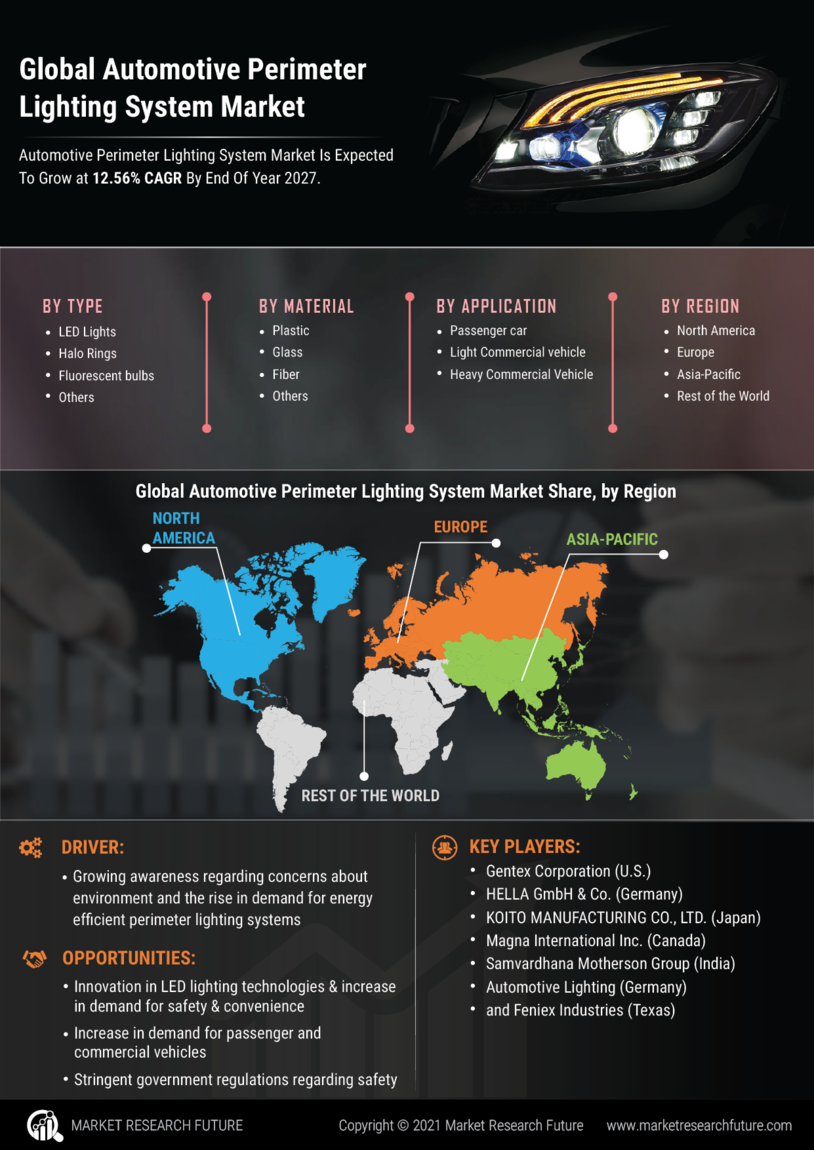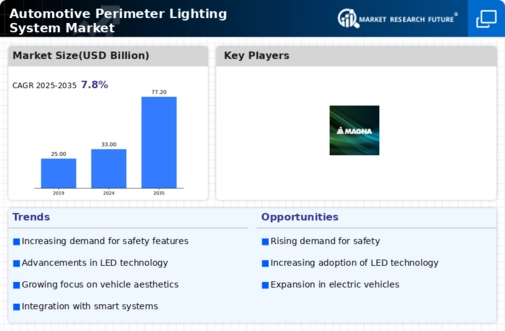Market Growth Projections
The Global Automotive Perimeter Lighting System Market Industry is poised for substantial growth, with projections indicating a market size of 33 USD Billion in 2024 and an anticipated increase to 77.2 USD Billion by 2035. This growth trajectory suggests a compound annual growth rate (CAGR) of 8.03% from 2025 to 2035, reflecting the increasing adoption of advanced lighting technologies and heightened consumer demand for safety and aesthetics in vehicles. The market's expansion is likely to be influenced by various factors, including technological advancements, regulatory changes, and evolving consumer preferences.
Growing Demand for Enhanced Safety Features
The increasing emphasis on vehicle safety is a primary driver for the Global Automotive Perimeter Lighting System Market Industry. Consumers and manufacturers alike are prioritizing advanced safety features, which include perimeter lighting systems that enhance visibility during nighttime or low-light conditions. This trend is particularly evident in regions with high traffic accident rates, where improved visibility can significantly reduce risks. As a result, the market is projected to reach 33 USD Billion in 2024, reflecting the growing consumer preference for vehicles equipped with such safety enhancements.
Expansion of Electric and Autonomous Vehicles
The rise of electric and autonomous vehicles is reshaping the Global Automotive Perimeter Lighting System Market Industry. These vehicles often incorporate advanced lighting systems that serve both functional and aesthetic purposes. For instance, perimeter lighting can enhance the visibility of electric vehicles during charging or when parked, while autonomous vehicles utilize lighting to communicate with pedestrians and other road users. As the market for electric and autonomous vehicles expands, the demand for sophisticated perimeter lighting systems is expected to grow, further driving market dynamics.
Rising Consumer Awareness of Vehicle Aesthetics
There is a notable increase in consumer awareness regarding vehicle aesthetics, which is influencing the Global Automotive Perimeter Lighting System Market Industry. Modern consumers are seeking vehicles that not only perform well but also exhibit stylish designs, including sophisticated lighting features. This trend is particularly pronounced among younger demographics who prioritize personalization and visual appeal. Consequently, manufacturers are incorporating advanced perimeter lighting systems to meet these aesthetic demands, thereby driving market growth. The anticipated CAGR of 8.03% from 2025 to 2035 indicates a sustained interest in enhancing vehicle design through innovative lighting solutions.
Technological Advancements in Lighting Solutions
Rapid advancements in lighting technology, such as the integration of LED and adaptive lighting systems, are propelling the Global Automotive Perimeter Lighting System Market Industry forward. These technologies not only improve energy efficiency but also enhance the aesthetic appeal of vehicles. The shift towards smart lighting solutions, which can adjust based on environmental conditions, is particularly noteworthy. As manufacturers adopt these innovations, the market is expected to experience robust growth, potentially reaching 77.2 USD Billion by 2035, driven by consumer demand for modern and efficient lighting systems.
Regulatory Support for Enhanced Lighting Standards
Government regulations aimed at improving vehicle safety and visibility are significantly impacting the Global Automotive Perimeter Lighting System Market Industry. Many countries are implementing stricter standards for automotive lighting, which encourages manufacturers to invest in advanced perimeter lighting systems. This regulatory support not only enhances safety but also fosters innovation within the industry. As manufacturers comply with these regulations, the market is likely to see increased adoption of perimeter lighting solutions, contributing to its projected growth trajectory. The alignment of industry practices with regulatory frameworks is essential for sustained market expansion.

















Leave a Comment